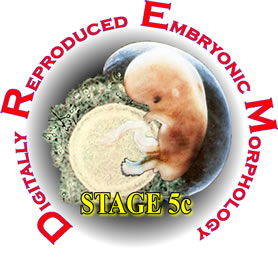

| Opening Screen | Embryo 7700 Figures | Download Section Images |
| Browse Sections | Flythrough Animations | Help / Instructions |
| 3D Models | Credits |
 |
|
|
Stage 5c is represented in the DREM databases by Carnegie embryo #7700 that has an estimated postfertilization age of 12 days and has been given a grade of excellent . The conceptus is superficially implanted and imperfectly covered by endometrial epithelium. The distinguishing characteristic at this substage is the presence of large, irregular, intercommunicating lacunar spaces that contain enough blood to form a discontinuous red circle about one mm in diameter that is visible on the endometrial surface. The bilaminar embryonic disc is composed of two, dorsally convex, cellular discs of approximately equal diameters; a thick epiblast and a thin hypoblast. The opposing surfaces of the two layers are flat without intervening mesoblast or mesoderm. The outline of the epiblast is pyriform in shape when viewed from above, revealing for the first time the embryonic disc axis. The epiblast is composed of large, vertically arranged cells whose nuclei are pseudostratified. Clear, oval, round or cylindrical vacuoles are mainly in the ventral part of the cells. The hypoblast is composed of medium-sized cuboidal or polyhedral cells that also contain cytoplasmic vacuoles. Extraembryonic mesoblasts are concentrated at the caudal end of the embryonic disc. The gastrulation (primitive) streak could not be identified. The conceptus lies just beneath an imperfectly eipthelialized surface. A fibrinous, leucocytic, hemorrhagic coagulum is present at the implantation site. The trophoblast just deep to the endometrial epithelium (abembryonic pole) is the least differentiated consisting of only a single layer of cuboidal cells. Elsewhere the wall of the conceptus consists of an outer syncytiotrophoblast (3/4 th ) and an inner cytotrophoblast (1/4 th ). The syncytiotrophoblast is composed of dark, eosinophilic cells with vacuolated cytoplasm containing dense nuclei of irregular size and shape. The cytotrophoblast is a single layer of large cuboidal or polyhedral cells of varying size and shape. Extraembryonic mesoblast and angioblast are forming deep to it and line the chorionic cavity. Several villi appear as clumps of cytotrophoblast that project into the syncytiotrophoblast and have at their base a core of mesoblast and angioblast. The inner surface of the mesoblastic layer is composed of flattened, elongated endoblast cells that form the exocoelomic membrane which together with the hypoblast forms the outer boundary of the primary umbilical vesicle (yolk sac). Above the dorsal surface of the embryonic disc is the nearly complete, dome-shaped, membranous amnion. Amnioblasts are delaminating from the adjacent cytotrophoblast. The embryonic disc measures 0.045 x 0.165 x 0.204 mm. The chorion measures 0.835 x 0.540 x 0.948 mm and the chorionic cavity measures 0.550 x 0.425 x 0.498 mm. ( click to see the Table of Dimensions from Hertig and Rock (1941)) The specimen was prepared for microscopic examination in 1938. It was fixed in Bouin's fluid, embedded in celloidin paraffin and serially sectioned at 6 µm. The sections were mounted on glass slides and stained with H & E. The database includes 140 sections through the conceptus of which 30 sections are through the embryonic disc. Structures are identified on every section image. The morphology of this specimen is well described in the literature, it was first described by Drs. Hertig, A.T. and Rock J. (1941) (Carnegie Instn. Wash. Publ. 184, Contrib. Embryology, 29:127-156). A three-dimensional reconstruction showing the inner features of the conceptus as well its relation to the surrounding endometrial glands and sinusoids is illustrated in that publication. The sections have been digitally restored and labeled, and can be viewed at three magnifications. A 3D reconstruction has been produced from the aligned sections. Animations of these 3D-reconstructions together with flythrough animations of the aligned sections are also included on the disks. For anyone who wishes to use them for other reconstructions, research or presentations, all of the original section images are available as individual .jpg files or as zip files. Help on using the disks can be found by going to the Instructions section. |
|